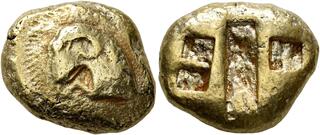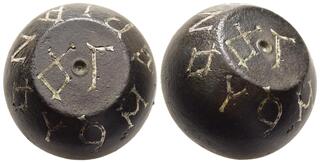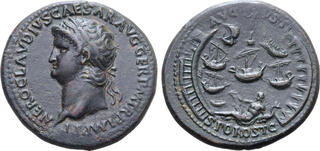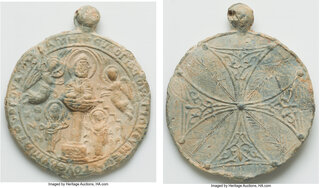Match 1:
Match 2:
Match 3:
Match 4:
| Leu Numismatik AG > Auction 15 | Auction date: 1 June 2024 |
| Lot number: 93 Price realized: This lot is for sale in an upcoming auction - Bid on this lot  | |
| Lot description: IONIA. Uncertain. Circa 650-600 BC. Stater (Electrum, 20 mm, 13.99 g), Lydo-Milesian standard. Curved forepart of a ram set to left on a striated convex surface. Rev. Central rectangular incuse punch, flanked by a slightly smaller rectangular punch on the left, intersected by a single line, and a small incuse square on the right, intersected by two cross-shaped lines. BMC -. BMFA -. Linzalone -. Pozzi 2367 (same die and punches). SNG Kayhan -. SNG von Aulock -. Traité -. Weidauer -. Of the highest rarity and the finest known example. Well centered and with one of the earliest figural types in numismatic history, an issue of tremendous numismatic and historical interest. Very fine. From a European collection, formed before 2005. The invention of coinage occurred in the 7th century BC in western Asia Minor. We know that the Lydian Kingdom played a significant role in this, not only because later Greek authors like Herodotus report it, but crucially because the epochal innovation of minting precious metal pieces according to a standardized and guaranteed weight standard is only conceivable against the backdrop of the militarily and economically dominant power of Asia Minor, namely the Lydian realm of the Mermnads. What we do not know is exactly by whom the first coins were minted - conceivable issuers include the Lydian kings themselves as well as various local elites such as tyrants or oligarchically organized Greek cities operating under Lydian suzerainty. The dating of the invention of coinage is also disputed, but it is now believed that the earliest coins were minted around 650-625 BC. Iconographically, the transition from blank to pictorially designed obverse dies likely occurred quite early. The boundaries between these are fluid, and the development did not occur in a strict chronological sequence. Additionally, early coin dies were sometimes used until completely worn out, so that pictorial motifs became unrecognizable over time (and the latter coins are then incorrectly assessed as earlier in chronological terms). This issue is evident not least in the highly exciting series of earliest electrum coins that we are pleased to offer in this catalog (Lots 90-105), where one can observe the increasing die wear very well. The present, extremely rare stater depicts on the obverse a schematic profile view of a ram's forepart on a striated convex surface. Whether this represents the coat of arms of a ruler, a deity, or a political community such as Klazomenai remains unclear, yet it undoubtedly is one of the earliest, securely identifiable pictorial representations on coins altogether, rendering it of the utmost historical, numismatic, and iconographic significance. Estimate: 25000 CHF |  |
Match 5:









